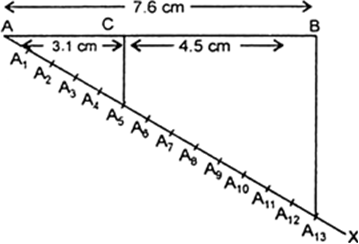Draw a line segment of length 7.6 cm and divide it in the ratio 5 : 8. Measure the two parts.
Steps of Construction :
(i) Draw AB = 5.6 cm
(ii) At a draw an acute ∠BAX below base AB.
(iii) On AX make 5 + 8 i.e. 13 equal parts and mark them as A1, A2, A3, A4,... A13
(iv) Join B to A13. From A5 draw A5C || A13B. C is the required point of division and AC : CB = 5 : 8.
On measuring, we get
AC = 3.1 cm,
CB = 4.5 cm
Justification :

[Using basic proportionally theorem]![]()
Therefore, ![]()
This shows that C divides AB in the ratio 5 : 8.





